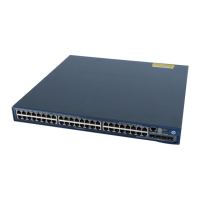30
Unselected: An Unselected port cannot forward user traffic.
Operational key
When aggregating ports, the system automatically assigns each port an operational key based on port
information such as port rate and duplex mode. Any change to this information triggers a recalculation of
this operational key.
In an aggregation group, all selected member ports are assigned the same operational key.
Configuration classes
Every configuration setting on a port might affect its aggregation state. Port configurations fall into the
following classes:
Port attribute configurations, including port rate, duplex mode, and link status (up/down). These are
the most basic port configurations.
Class-two configurations. A member port can be placed in the Selected state only if it has the same
class-two configurations as the aggregate interface.
Table 2 Class-two configurations
Whether the port has joined an isolation group
QinQ enable state (enable/disable), TPID for VLAN tags, outer VLAN tags to
be added, inner-to-outer VLAN priority mappings, inner-to-outer VLAN tag
mappings, inner VLAN ID substitution mappings
Permitted VLAN IDs, PVID, link type (trunk, hybrid, or access), IP subnet-based
VLAN configuration, protocol-based VLAN configuration, VLAN tagging mode
MAC address learning capability, MAC address learning limit, forwarding of
frames with unknown destination MAC addresses after the MAC address
learning limit is reached
NOTE:
Class-two configurations made on an aggregate interface are automatically synchronized to all member ports of
the interface. These configurations are retained on the member ports even after the aggregate interface is
removed.
Any class-two configuration change might affect the aggregation state of link aggregation member ports and
ongoing traffic. To be sure that you are aware of the risk, the system displays a warning message every time you
attempt to change a class-two configuration setting on a member port.
Class-one configurations do not affect the aggregation state of the member port even if they are
different from those on the aggregate interface. GVRP and MSTP settings are examples of class-one
configurations.
Reference port
When setting the aggregation state of the ports in an aggregation group, the system automatically picks
a member port as the reference port. A Selected port must have the same port attributes and class-two
configurations as the reference port.

